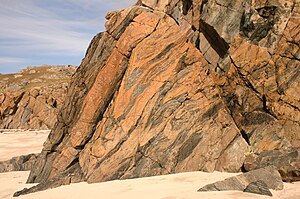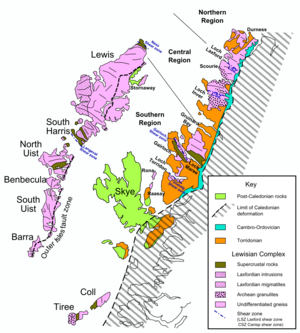Lewisian
The Lewisian is a series of highly metamorphic gneisses in the basement of the Hebridean Terran .
etymology
The Lewisian, engl. Lewisian complex or Lewisian gneiss , was named after the island of Lewis in the Outer Hebrides .
General

The rocks of the Lewisian date from the Archean and Paleoproterozoic , their age ranges between 3000 and 1700 million years BP . They form the basement on which the sediments of the Torridonian Supergroup and the Moine Supergroup were deposited. The Lewisian consists primarily of gneisses of granitic composition , with supracrustal rocks as well. The Lewisian was also included in the Caledonian orogeny and forms the hanging wall of many thrust faults from the late stage of this orogeny .
Occurrence
The rocks of the Lewisian are exposed on the islands of the Outer Hebrides, including the Isle of Lewis, the eponymous type locality . Nevertheless, they can be found on several islands in the Inner Hebrides . On the opposite mainland, they form an approximately 20 km wide strip that extends from Cape Wrath in the north to Loch Torridon in the south. Their presence on the sea floor in the Minch and under Paleozoic and Mesozoic sediment cover west of Shetland has been proven by magnetic field measurements, shallow drilling and oil drilling.
Similar basement rocks now commonly considered Lewisian occur at the base of the Moine Supergroup. Here, too, the discordant relationships are often very open. The Lewisian continues in a southeast direction at least as far as the Great Glen Fault . Granitic gneisses of Paleoproterozoic age, which are very similar to the Lewisian, form the so-called Rhinns complex , which can be found on Islay and Colonsay in the south of the Inner Hebrides. The basement rocks on Inishtrahull on the north coast of Donegal and in County Mayo in Ireland (the Annagh gneiss complex ) are also likely to be part of the Lewisian.
Research history
The first comprehensive scientific study of the Lewisian dates back to 1907. It was part of a memoir by the British Geological Survey on the structural design of the Northwest Highlands .
An even older work from 1888 goes back to Peach et al.
Building on the work of 1907, John Sutton and Janet Watson interpreted the metamorphic and tectonic development of the Lewisian in 1951 as a sequence of discrete, in the terrain recognizable orogeny phases. Thus, they used a doleritischen transition swarm - the Scourie dykes - as a marker to a Scourian which was older than the gears, by a younger Laxfordian separate, which deformed the gears and metamorphosed. More recent field studies, works on metamorphosis and radiometric age dating have confirmed their initial hypothesis and further refined their chronological classification.
Lewiasian in mainland Scotland
Scourian
The oldest part of the Lewisian are archaic gneisses, which were formed in the period 3000 to 2700 million years BP. These gneisses of the Scourian are in the central part of the Lewisian on the Scottish mainland. Lithologically, they consist mainly of banded, gray gneiss with a characteristic granodioritic , tonalitic or Trondhjemitic composition. It is therefore an orthogneiss , whereas paragneiss of metasedimentary origin is relatively rare.
The original rocks of the Scourian are predominantly granitic in nature, but subordinate mafic and ultramafic rocks give the gneiss a bimodal character. Differences in their age as well as in the subsequent tectono-metamorphic evolution suggest three different crustal blocks on the mainland.
Badcallian
The so-called Badcallian represents the principal metamorphosis in the central crustal block. It reached the high-grade conditions of the granulite facies and is dated to 2,750 million years BP. There are no signs of granulite facies in the northern crustal block. In the southern crustal block, the Badcallian is locally dated to 2,730 million years BP.
Inverian
The tectono-metamorphic event of the Inverian follows the granulite facial metamorphosis of the Badcallian, but is older than the intrusion of the Scourie dykes. Pegmatites , which emerged between 2,490 and 2,480 million years BP after the Badcallian, were probably deformed by the Inverian between 2,480 and 2,420 million years BP. Their deformation was accompanied by a retrograde, amphibolite facial metamorphosis , comparable to the Laxfordian that followed later . Unfortunately it is not always possible to clearly distinguish the Badcallian from the Inverian. In the central and southern crustal blocks, shear zones that had formed during the Inverian, including the Canisp Shear Zone, could be identified .
Scourie dykes
The Scourie dykes are a mafic gang swarm that penetrates the gneiss bands of the Scourian and must therefore be younger than the gneiss formation processes. However, the absolute age is difficult to determine due to later metamorphosis and tectonic deformations. The only reliable radiometric ages were obtained in the central crustal block at around 2,400 million years BP. Dikes penetrated into cooler crustal areas only provided an age of 2000 million years BP. This should also be the age of warehouse aisles in the Loch Maree Group . Some of the main dikes are obviously intruded into warmer crustal stretches as well. Geochemically , the Scourie dykes are predominantly quartz-bearing dolerites, but they can also occur as vein equivalents of olivine-containing gabbros , norites and bronzite picrites .
Laxfordian
The Laxfordian was originally excreted because of the deformation and metamorphosis observed in the Scourie dykes. In the Laxfordian, an early event that is older than 1700 million years BP and is characterized by the retromorphism of the Scourian from the granulite to the amphibolite facies and a late event with retromorphism to the green slate facies can be distinguished. The late event partly contains ages that can be counted as part of the Grenville orogeny (ie around 1100 million years BP). The early event is primarily associated with shear zones, in which deformed Scourie dykes occur as amphibolite inserts in reworked gneiss. The original mineralogical composition of the veins has changed to an amphibolite facial mineral stock even in undeformed areas. In the northern and southern crustal blocks, structures from the early event are interspersed with granites and pegmatites dated 1700 million years BP.
Loch Maree Group
The supracrustal rocks of the Loch Maree Group are present in the southern crustal block in two areas (at Loch Maree and at Gairloch ). The group emerged from metasediments with intermediate amphibolites . These amphibolites are interpreted as metavolcanites, into which mafic camp passages had penetrated. The rocks are likely to have been deposited around 2000 million years BP, as indicated by detritic zircons , the age of which is composed of archaic and paleoproterozoic components.
Lewisian of the Outer Hebrides
The Lewisian of the Outer Hebrides is largely formed by gneisses of the Scourian, which were then intruded by granites. The changes to the rock structure caused by the Laxfordian were so extensive that only a small amount of the original crust of the Scourian survived. Amphibolite layers interpreted as Scourie dykes are much rarer in comparison with the mainland. On the other hand, the supracrustal rocks are far more common in the Outer Hebrides, making up around 5% of the total surface. Their relationship to the Scourian basement has not yet been fully clarified.
Plutonic rocks from South Harris
The Plutonic rocks of South Harris consist predominantly of anorthosite and metagabbro, tonalite gneisses and pyroxene-bearing granulite gneisses are rare. They invaded the supracrustal rocks of Leverburgh and Langevat . The intrusion extended from 2200 to 1900 million years BP, as shown by radiometric dating. This coincides with the Loch Maree Group's educational age. The Ness anorthosite at the northeast tip of Lewis is also associated with metasediments and has a comparable Sm-Nd model age of 2200 million years BP. It is quite possible that the Plutonic solids of South Harris and Ness were once connected and only pulled apart and separated from one another by the deformations of the Laxfordian.
Metasediments of Langevat and Leverburgh
The two metasediment belts of Langevat and Leverburgh flank the Plutonic rocks of South Harris. These are the largest metasediment deposits in the Outer Hebrides. Radiometric dating could assign these rocks a paleoproterozoic age, roughly comparable to the age of the Loch Maree Group. The relationship between these metasediments and the Scourian basement gneisses has not been fully clarified.
Outer Isles fault zone
The fault zone of the Outer Isles extends over the total length of the Outer Hebrides, ie around 200 kilometers. Their angle of incidence is 20 to 30 ° to the east-northeast. The rocks within the fault zone have a long and complex sequence of movements behind them, with fault breccias , mylonites and even pseudotachylites forming and thus documenting movements at very different crustal depths.
Occurrence of the Lewisian within the Moinian Supergroup
Gneiss deposits within the Moine Supergroup are often very similar to the Lewisian, although they have been overprinted several times. But there are definitely important differences. The largest of these deposits, the Glenelg-Attadale Inlier , shows signs of eclogite-facial metamorphosis . The two ceilings exposed within the window were recorded, which were created during the Paleoproterozoic Era (around 1700 million years BP) and during the Grenville Orogeny (around 1100 million years BP) in the course of the crust thickening.
Web links
Individual evidence
- ↑ a b c d e f Park, RG; Stewart, AD; Wright, DT: 3. The Hebridean terrane . In: Trewin NH The Geology of Scotland . Geological Society, London 2003, ISBN 978-1-86239-126-0 , pp. 45-61 .
- ↑ C. Michael Hogan: Sea of the Hebrides . In: Eds. P.Saundry & CJCleveland. Encyclopedia of Earth . National Council for Science and the Environment., Washington DC 2011.
- ↑ Kirton, SR; Hitchen, K .: Timing and style of crustal extension N of the Scottish mainland . In: Coward MP, Dewey JF & Hancock PL Continental Extensional Tectonics . Special Publications 28. Geological Society, London 1987, ISBN 978-0-632-01605-1 , pp. 501-510 .
- ↑ Flowerdew, MJ; Chew DM, Daly JS & Millar IL: Hidden Archaean and Palaeoproterozoic crust in NW Ireland? Evidence from zircon Hf isotopic data from granitoid intrusions . In: Geological Magazine . tape 146 . Cambridge University Press, 2009, pp. 903-916 .
- ^ John Horne , William Gunn, Charles Thomas Clough , Jethro Justinian Harris Teall & Lionel Wordsworth Hinxman : The geological structure of the North-West Highlands of Scotland . (Memoirs of the Geological Survey of Great Britain), James Hedderwick & sons, Glasgow 1907, p. 668 ( online in the library of the BGS )
- ↑ Peach, BN; Horne J., Gunn W., Clough CT, Hinxman L. & Cadell HM: Report on the Recent Work of the Geological Survey in the North-west Highlands of Scotland, based on the Field-notes and Maps . In: Quarterly Journal of the Geological Society . tape 44 , 1888, pp. 378-441 .
- ↑ Sutton, J .; Watson, J .: The pre-Torridonian metamorphic history of the Loch Torridon and Scourie areas in the north-west Highlands, and its bearing on the chronological classification of the Lewisian . In: Quarterly Journal of the Geological Society . tape 106 . London 1951, p. 241-307 .
- ↑ Storey, C .: The Glenelg-Attadale Inlier, NW Scotland, with emphasis on the Precambrian high-pressure metamorphic history and subsequent retrogression: an introduction and review . In: Scottish Journal of Geology . tape 44 (1) , 2008.



